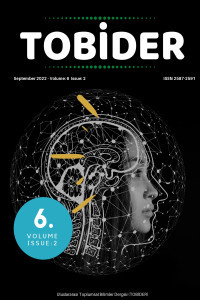ECHOES OF “CANTO III,” “CANTO IV,” AND “CANTO XXXII” IN “THE WASTE LAND”
The purpose of this article is to examine the three allusions to Dante’s Inferno which Eliot outlines in the notes on “The Waste Land.” By drawing upon minute details from “Canto III” this work parallels the London clerks from “The Burial of the Dead” with the uncommitted in Hell’s vestibule. This article conveys how Eliot’s vision is reminiscent to that of the pilgrim, but also how it differs from the pilgrims account as well. This article also elucidates on Eliot’s evocation of “Canto IV,” as well as its effect on Eliot’s vision. By drawing upon certain echoes from Dante’s portrayal of Limbo, this article conveys how “Canto IV” reverberates in the London clerks segment of “The Burial of the Dead,” but also how it challenges some aspects of the clerks portrayal. With regards to Eliot’s allusion to “Canto XXXII” in “What the Thunder Said” this article delineates upon a parallel with Cocytus, rather than with Ugolino.
Anahtar Kelimeler:
T.S. Eliot, Dante Alighieri, The Divine Comedy, The Waste Land, Modernism.
ECHOES OF “CANTO III,” “CANTO IV,” AND “CANTO XXXII” IN “THE WASTE LAND”
The purpose of this article is to examine the three allusions to Dante’s Inferno which Eliot outlines in the notes on “The Waste Land.” By drawing upon minute details from “Canto III” this work parallels the London clerks from “The Burial of the Dead” with the uncommitted in Hell’s vestibule. This article conveys how Eliot’s vision is reminiscent to that of the pilgrim, but also how it differs from the pilgrims account as well. This article also elucidates on Eliot’s evocation of “Canto IV,” as well as its effect on Eliot’s vision. By drawing upon certain echoes from Dante’s portrayal of Limbo, this article conveys how “Canto IV” reverberates in the London clerks segment of “The Burial of the Dead,” but also how it challenges some aspects of the clerks portrayal. With regards to Eliot’s allusion to “Canto XXXII” in “What the Thunder Said” this article delineates upon a parallel with Cocytus, rather than with Ugolino.
Keywords:
T.S. Eliot, Dante Alighieri, The Divine Comedy, The Waste Land, Modernism,
___
- Dante Alighieri, The Divine Comedy, trans. Allen Mandelbaum (New York: Columbia University Libraries, 2018), https://digitaldante.columbia.edu/dante/divine-comedy/
- T. S. Eliot, “The Waste Land,” Poetry Foundation, accessed September 12, 2022. https://www.poetryfoundation.org/poems/47311/the-waste-land
- Oliver Tearle, “A Summary and Analysis of T. S. Eliot’s The Waste Land,” https://interestingliterature.com/2016/10/a-summary-and-analysis-of-t-s-eliot-the-waste-land/
- Teodolinda Barolini, “Inferno 3: Crossings and Commitments,” in Commento Baroliniano (New York: Columbia University Libraries, 2018), https://digitaldante.columbia.edu/dante/divine-comedy/inferno/inferno-3/
- F. O. Matthiessen, The Achievement of T.S. Eliot (Michigan: Boston and New York Houghton Mifflin Company, 1935), 52. https://babel.hathitrust.org/cgi/pt?id=mdp.39015003856344&view=1up&seq=7&skin=2021
- Frederick Locke, “Dante and T.S. Eliot’s Prufrock,” The John Hopkins University Press 78, no. 1 (1963): 52.
- Anthony Oldcorn, “Canto III” in Lectura Dantis: Inferno: A Canto-by-Canto Commentary (Los Angeles: University of California Press), 41.
- John Ciardi, “Canto III” in The Inferno (New York: Signet Classics), 45.
- Robert A. Day, “The ‘City Man’ in The Waste Land: The Geography of Reminiscence,” Modern Language Association 80, no. 3 (1965): 285.
- Oliver Tearle, The Great War, The Waste Land, and the Modernist Long Poem (London: Bloomsbury Academic), 60.
- Teodolinda Barolini, “Inferno 4: Non-Christians in the Christian Afterlife,” in Commento Baroliniano (New York: Columbia University Libraries, 2018), https://digitaldante.columbia.edu/dante/divine- comedy/inferno/inferno-4/
- Dante Alighieri. “Notes on Canto XIII.” In The Divine Comedy. Translated by Dorothy L. Sayers. London: Penguin Classics, 1950.
- Başlangıç: 2017
- Yayıncı: Sadık Hacı
Sayıdaki Diğer Makaleler
XIX. YÜZYIL İKİNCİ YARISINDA BULGAR EDEBİYATINDA YENİ ARAYIŞLAR
ERZİNCAN’DA SİYASAL YAŞAMIN TEMSİLCİLERİ: SİYASAL ELİTLER (1980-2022)
UZAKTAN EĞİTİM SÜRECİNDE ÖĞRETMEN VE ÖĞRENCİ BAKIŞ AÇISI İLE ORTAÖĞRETİM TARİH DERSLERİ
FRANSA’DA YAŞAYAN ÜÇÜNCÜ NESİL TÜRKLERİN UYUMU, KİMLİK ALGILARI VE DİL TERCİHLERİ
Cansu CANDEMİR ÖZKAN, Füsun SARAÇ, Mehmet Ali AKINCI
MİMARİ CEPHELER VE HEYKEL SANATI ETKİLEŞİMİ; SEÇKİN PİRİM ÖRNEĞİ
GÜNÜMÜZ TEKNOLOJİSİNDE MÜZİK KAYIT PROGRAMLARININ YERİ VE ÖNEMİ
ÇAĞDAŞ VE KLASİK YUNANCA OKUYAN ÖĞRENCİLERİN GEREKSİNİM, GÜDÜLENME VE TUTUM ANALİZİ
